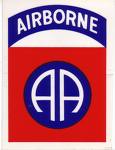
UNITED STATES ARMY POWER PROJECTION IN THE 21st CENTURY: THE CONVENTIONAL AIRBORNE FORCES MUST BE MODERNIZED TO MEET THE ARMY CHIEF OF STAFF'S STRATEGIC FORCE REQUIREMENTS AND THE NATION'S FUTURE THREATS.
CHAPTER THREE
U.S. AND SOVIET POST-WAR AIRBORNE DEVELOPMENT

Colonel I. I. Andrukhov and Colonel V. Bulatnikov (1966) (1)
INTRODUCTION
During the immediate postwar years, America celebrated victory by demobilizing their military while the Soviets concentrated their Analytical energies on building an armed force that could guarantee their security for future generations. They would study the historical lessons of the war and then proceed to build for the future. (2)
Following their "demobilization", the Soviets still had as many as 175 Division-sized units and had increased the size of their mechanized forces from 39 to 65 divisions. (3) They were willing to pay, whatever the price, to protect themselves from another attack from the west. The Soviets, in short, were committed to the modernization of their military and with it their Airborne forces.
This chapter will address the divergent paths taken by the Soviet Union and the U.S., after World War II, in the development of their Airborne doctrine, organization and equipment.
THE POSTWAR YEARS -- SOVIET AIRBORNE DEVELOPMENT (1946 - 1953)
Immediately following World War II, the Soviet Union reformed its military. The theories, practices and organizations that contributed most to their victory in World War II were emphasized. Mechanized armies of armored-heavy maneuver units emerged. These powerful mobile forces received the bulk of the attention and the resources. However, the Soviets also maintained a significant Airborne force, of as many as TEN Divisions, containing a mixture of both Airborne and glider troops. Additionally, Soviets military theorists intensely studied the war experiences in an effort to define the precise missions the Airborne forces should perform. They identified tactical, operational and strategic missions which included the disruption of enemy mobilization and the seizure of industrial regions, island and beaches. Two factors, however, prevented the Airborne forces from attaining a primary status in the new Soviet force structure. The first was Stalin's severe reservations about the survivability of Airborne forces in modern mechanized combat. The ghosts of the operational Airborne failures at Vyaz'ma and Dnepr were still too vivid. The second, was the lack of technological assets, specifically inadequate life aircraft, insufficient heavy weapons and limited ground mobility.
The capabilities and availability of lift aircraft were especially restrictive to the development of the Airborne forces. The air transport of the 1940s could only lift personnel and light weapons or vehicles. Because of these lift limitations, the Airborne forces had to stay light. So, despite the concerted effort to improve the Airborne forces' weaponry, the rearmament of the Airborne consisted only of improved anti-tank guns, 120-mm mortars, recoilless rifles and some light vehicles. The parachute battalions still advanced and attacked on foot with limited organic fire support. This problem of inadequate lift aircraft would not be soon fixed. Soviet aircraft construction emphasized creating long-range bomber aviation and air defense aircraft. Nevertheless, as resources became available, a number of aviation design bureaus worked to develop an improved transport aircraft.(5) Their effort would eventually results in the production of the Soviets first long-range assault transport aircraft, the Antonov AN-8, but not until 1956.
The requirement to stay light also limited the employment doctrine of the Airborne forces. The weaponry available and the air delivery capability of the Air Force determined the Airborne forces' potential capability. Until technology could respond with a significant increase in aircraft lift capability, the Airborne missions could not change much from those assigned in World War II. Essentially the Airborne forces were limited to seizing and holding terrain until linkup with ground forces could be accomplished. Their missions remained passive because after landing , Paratroopers lacked the mobility and heavy mobile firepower to attack. (6) Despite these limitations, Airborne operations remained an essential part of the Soviet offensive theory. Having identified the limitations, the Soviets would work to correct them.